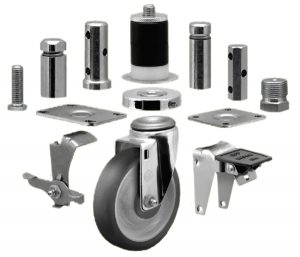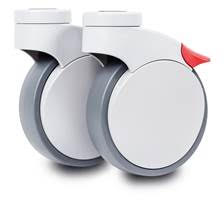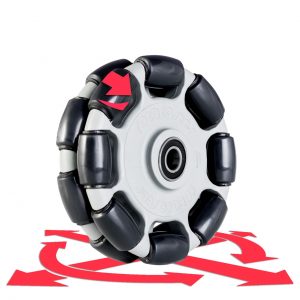
There are only two reasons why one would ask how to buy a caster. The first is if you are holding a worn out one in your hand. The second is if you are a manufacturer incorporating a caster in your product. Either way you want to know some caster buying basics.
Caster Basics.
The modern caster allows heavy items to be rolled easily in tight or limited spaces. Casters allow 360 degrees of motion in any direction with a minimum of force. They are on furniture, grocery carts, hospital beds, and many industrial material handling products.They are an Industrial commodity. Because of this they are typically produced in automated Manufacturing plants at high speed to lower their cost. Like all Industrial commodities there are multinational sources of supply. The caster at the hardware store could have been made in any number of countries.
If you are replacing a bad caster then it best be on a high-volume standard item like a grocery cart or piece of furniture. If it is older or was a custom caster, then you may want to replace all the casters with the closest available choice. In any case a trip to your Hardware store, Industrial supply store, or an online search are your choices. Somewhere on that caster may be the info you need to find it, in the form of a logo or part number. If you cannot find that then you go looking for the application, like “Industrial cart caster” google away!
If you are including casters in your manufactured part the dynamics are much different. You will likely be talking to an industrial distributor of “Material Handling” products, of which casters are a major driver. If you are buying hundreds of thousands of casters, you may still best be served by the distributor with multiple options in sources. Most high-volume casters are not sold directly by the manufacturer. They are sold by distributors or industrial supply houses. In high volumes you need to bypass the Industrial distribution retailer’s and get the product where they do……..The stock and sell distributor. They will offer multiple lines at multiple quality levels and price points. Retailers like Grainger or Fastenal are not set up to be competitive in very high volumes. Here is what your Caster partner needs to know when you call.
- What is the casters application
This will save a lot of time because caster designs have evolved to suit the needs of different Industries. You say hospital equipment and it means one thing, say grocery cart or office chair and it means another. There are so many choices and so much data available that using the supplier as a reference point will always pay a dividend. If you are going to search online be ready to have a lot of choices because a search for “luggage casters” will get 7,000,000 hits. Your distributor can save you a lot of time with input like “We need casters for our new Intra oral camera cart for use in dentist offices”
- What is the casters function
There are two types of basic caster. The fixed caster and the swivel caster. They can be used together or separately depending on the application. Your office chair may use 4 swivel casters or a grocery cart two of each. Some casters come with features like brakes to hold them stationary. The service carts on airplanes has this feature. Be prepared to tell your partner what the caster does
Speccing a Caster
Type: Fixed/Swivel/Brake
Casters are made in many styles and many materials and the combination can literally result in thousands of choices. The basics of speccing out a caster must include:
Weight rating: Ranges from light duty to heavy duty Industrial

Mounting style: varies from a post or stem going in a socket to heavy duty bolts.
Wheel size: always measured in outside diameter
Material: This includes the frame, the wheel, the tire, and other hardware. Rubber for tires is measured by durometer, which is related to wear resistance.
So, your spec requirement might be to look for “A fixed heavy-duty Industrial caster with a steel Bolt on frame holding a 5-inch aluminum wheel with a high durometer rubber tire and a weight rating of 750 lbs.”. Search that on the internet and as specific as it is it will still get you thousands of choices. That is why Industrial Distributors like Monroe Engineering exist. There are just so many choices that ‘an expert” comes in handy.
Common Caster Terms
Like many Industrial products caster parts and their description are a mish mash of language that has evolved over time. Here are illustrations and the nomenclature related to each part of a caster.
Vehicle: This is what the caster is mounted to and enables movement of. The “vehicle can be a chair, a bed, an industrial cart. The largest vehicle to use a caster that I know of was the B-29 Bomber, its nose wheel was a caster!
Swivel Radius / Offset / Lead / Trailing distance: All these terms refer to the secret sauce that makes swivel casters special. By offsetting the axis of rotation from the center of the axle the wheel is always seeking to follow that “lead” by pivoting and following the direction of any force on it. (see how casters work). The distance between the axes of rotation and the center of the axle is described by all the above phrases. That distance is variable, and the design of each caster is a compromise of strength and utility that has evolved over time with practical use. It may not be a common term in ordering a caster but will become a topic if you are having some issues with a caster in use.
Bolt hole Spacing: Heavy duty casters are typically bolted on to the “vehicle”. The top of the caster frame will have 4 holes. Of course, the hole pattern on the caster must match the hole pattern on the vehicle.
Swivel Bearing: The ability to pivot or rotate a caster 360 degrees is what makes it work. This pivoting action must be smooth and offer the least resistance possible. If the caster does not pivot it does not work. Failure or wear of the swivel bearing is the cause of many caster problems. Nearly every type of bearing is used but most are the “roller” style. These use ball bearings inside a “race”. Most are dry, but heavy-duty applications can require grease or lubrication.
Caster Size: this refers to the diameter of the wheel only, to include the tire if the caster Has one mounted to the wheel.

Top Mounting Surface: this is the part of the caster that fits flush to the underside of the “vehicle”. If the caster is mounted using a stem the top mounting surface is NOT, the top of the stem.
Overall Height / Load Height: The distance from the top mounting surface to the bottom of the wheel.
Stem / Spindle: Light duty casters are installed by having a stem that is pushed into a matching socket on the Vehicle. The diameter of the stem and socket must match, and the diameter and length of the stem determine its strength.
Durometer: For casters with rubber tires the durometer is the measure of the wear resistance of the rubber. Low durometer is quiet and creates a rapid responding caster for smooth surfaces. High durometer transmits more of any floor imperfection into the “ride quality” of the vehicle but wears much better. Hospital rubber wheels would have a low durometer. Industrial casters a high durometer.
Fixed caster: this is a wheel mounted to a frame that does not swivel or rotate.
Swivel caster: this caster pivots with force to go any direction.
Brake Caster: this caster has a mechanical lock that fixes it in position. The airline drink cart is a good example.
Axle shaft / Axle bearing: All casters include a frame and an axle which retains the wheel and allows it to roll. The wheel must roll easily for casters to work as the rolling resistance must be less than the force exerted on the side of the caster when pushed in a different direction than it is facing. If the wheel does not spin, then the caster will not pivot and will slide across the floor. A worn axle or axle bearing is a common cause of caster failure.
Fork: This is the part of the caster frame that holds the wheel in place. A curved fork is often used to hold the wheel at the correct “trail” or “offset” to enable the caster to do its job.
